#Atlas by Lee Lawrie and Rene Paul Chambellan
Explore tagged Tumblr posts
Text




















Rockefeller Center declared a National Historic Landmark on September 26, 1988.
#Rockefeller Center#National Historic Landmark#26 September 1988#USA#US history#Radio City Music Hall#Art Deco#Manhattan#travel#New York City#summer 2018#2019#original photography#Raymond Hood#landmark#tourist attraction#30 Rock#sculpture#Atlas by Lee Lawrie & Rene Paul Chambellan#International Building#facade#anniversary#vacation#architecture#cityscape
5 notes
·
View notes
Text
Atlas
Installed 1937
Lee Lawrie and Rene Paul Chambellan
Decorating the 2023 Rockefeller Center Christmas Tree https://attemptedbloggery.blogspot.com/2023/11/decorating-2023-rockefeller-center.html #NYC

0 notes
Photo
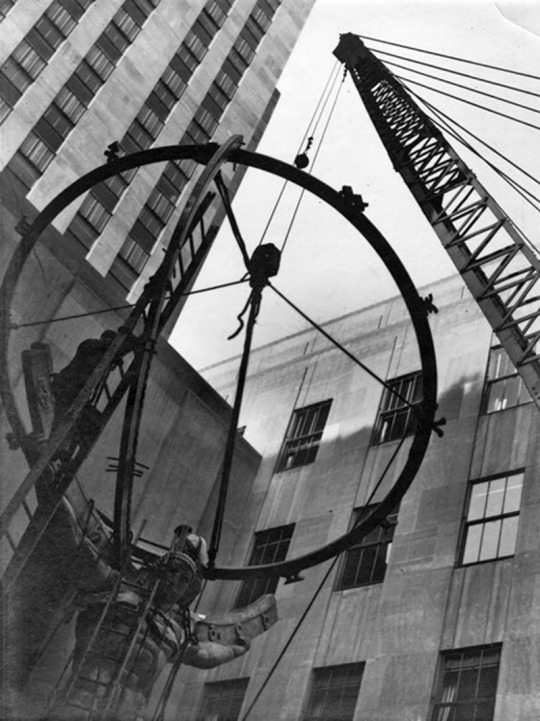
The bronze sculpture of Atlas being lowered into place in Rockefeller Center Plaza, 1937. I can’t tell whether it’s the whole sculpture (45 feet/14 meters) that they’re hauling or just the globe (30 feet/9.14 meters).
Photo: Eliot Elisofon via the Alan Klotz Gallery Sculpture: Lee Lawrie & Rene Paul Chambellan
#New York#NYC#vintage New York#1930s#Eliot Elisofon#Atlas statue#Lee Lawrie#Rene Paul Chambellan#sculpture#Rockefeller Center
139 notes
·
View notes
Photo

Ace of Disks. Art by Robin Scott, from The Urban Tarot.
The Tao Te Ching speaks of The Ten Thousand Things—the infinite bountiful variety of what the world has to offer. When we refer to the element of Earth, we’re talking about more than the ground beneath our feet. The Disks talk to us about our bodies, our health, our homes, our labors, and our financial fortunes.
The Ace is the root of all those Ten Thousand Things, and the very first step of a new project. Before something can be made, first it must be imagined. The journey of the Disks might make the most sense if we think about it as the process of opening a new business. On day one, Disks Incorporated has a name. We have decided to begin a new operation and we will see where it takes us.
The central figure on this card is Atlas by Lee Lawrie and Rene Paul Chambellan, a well-known sculpture at the entrance of Rockefeller Center. The stone he’s stepping onto is representative of the Shorakkopoch boulder, which lies in a quiet area of Inwood Hill Park, far uptown. Shorakkopoch is the little-known memorial that purports to mark the place where Peter Minuit purchased the island of Manhattan from the Lenape Indians in 1626. Whether this purchase ever really took place, whether it was on this spot, and whether either party had any legitimate right to make the exchange in the first place is sort of beside the point. It’s a pervasive legend of how this city came to be, and if New York has a cornerstone, I would suggest that it is this rock.
The design I’ve used for the disks in this suit was based on the “Five Boroughs” token, the last subway token in circulation before the complete switchover to a digital card system in 2003. It’s combined with the elemental symbol for Earth, pointing inward.
Completed in September 2012
6 notes
·
View notes
Photo

ATLAS at The Rock: Atlas is a bronze statue in front of Rockefeller Center within the International Building's courtyard in Midtown Manhattan, New York City, across Fifth Avenue from St. Patrick's Cathedral. The sculpture depicts the Ancient Greek Titan Atlas holding the heavens. Atlas was installed in 1937 and created by the sculptor Lee Lawrie with the help of Rene Paul Chambellan. The sculpture is in the Art Deco style, as is the entire Rockefeller Center. The Atlas statue in the sculpture is 15 feet (4.6 m) tall, while the entire statue is 45 feet (14 m) tall. It weighs 7 short tons (6,400 kg), and is the largest sculpture at Rockefeller Center. Atlas is depicted carrying the celestial vault on his shoulders. The North-South axis of the armillary sphere on his shoulders points towards the North Star's position relative to New York City. The statue stands on one muscular leg atop a small stone pedestal, whose corner faces Fifth Avenue. (all info borrowed from Wikipedia) George L. Rosario NYC's Hometown Realtor Luxe Stone New York at eXp Builder/Speaker/Entrepreneur CONTACT: 347-671-SOLD www.GEORGEROSARIO.com #glrosario #NYCsHometownRealtor #eXpRealty #NewYork #NewYorkCity #LuxeStoneNY #Realtor #atlas #atlasstatuenyc #LIONSquad #Brooklyn #Queens #Manhattan #Bronx #stpatrickscathedral #atlasnyc #CityLife #ILoveNYC #stpatrickscathedralnyc #statue #nycstatues #statuesofnyc #walkingnewyork #walknyc #explorenyc #expproud #exprealtyproud #newyorkers #PowerAgentsRock #nycprimeshot Want a lucrative career selling New York? Join our team and share your NYC story. Positivity-Driven agents only need apply. Serving The Greater New York City Area Brooklyn, Queens, Manhattan, Bronx, Staten Island, Suffolk & Nassau. (at Atlas (statue)) https://www.instagram.com/p/B45Qro0HAH5/?igshid=1pgrtmuvyv9m8
#glrosario#nycshometownrealtor#exprealty#newyork#newyorkcity#luxestoneny#realtor#atlas#atlasstatuenyc#lionsquad#brooklyn#queens#manhattan#bronx#stpatrickscathedral#atlasnyc#citylife#ilovenyc#stpatrickscathedralnyc#statue#nycstatues#statuesofnyc#walkingnewyork#walknyc#explorenyc#expproud#exprealtyproud#newyorkers#poweragentsrock#nycprimeshot
0 notes
Photo

“Atlas” by sculptor Lee Lawrie with the help of Rene Paul Chambellan. Installed in 1937, the sculpture is in the Art Deco style. Atlas in the sculpture is 15 feet tall, while the entire statue is 45 feet tall, as high as a four-story building. The North-South axis of the armillary sphere on his shoulders points towards the North Star as seen from New York City. When Atlas was unveiled in 1937, some people protested, claiming that it looked like Italian dictator Benito Mussolini. Later, painter James Montgomery Flagg said that Atlas "looks too much as Mussolini thinks he looks". via wikipedia. #atlasshrugged #nyc #objectivism #sculpture http://ift.tt/2jfyvkK
4 notes
·
View notes
Photo










Rockefeller Center, Manhattan (No. 2)
The current complex is a combination of two building complexes and a standalone building: the original 14 Art Deco office buildings from the 1930s, one building across 51st Street built in 1947, and a set of four International-style towers built along the west side of Avenue of the Americas during the 1960s and 1970s. The center spans 22 acres (8.9 ha) in total, with some 17,000,000 square feet (1,600,000 m2) in office space.
The landmarked buildings comprise 12 acres (49,000 m2) in Midtown, bounded by Fifth and Sixth avenues between 48th and 51st streets. Built as a cohesive unit, the buildings have been owned by Tishman Speyer since 2000.The buildings are spread along six blocks, with three blocks facing each avenue. These six blocks are the size of three standard blocks. One of the landmark buildings' defining features is the Indiana limestone facade possessed by all 14 structures, as specified in the original plans. All of the structures were designed by Associated Architects, with Raymond Hood as the principal architect, and are listed on the National Register of Historic Places.
Source: Wikipedia
#Royal British Coat of Arms by Carl Paul Jennewein#Rockefeller Center#Art Deco#detail#GE Building#30 Rockefeller Plaza#Raymond Hood#RCA Building#architecture#Midtown Manhattan#New York City#original photography#vacation#summer 2018#cityscape#tourist attraction#Palazzo d'Italia#Italia by Giacomo Manzù#Atlas by Lee Lawrie and Rene Paul Chambellan#International Building#Youth Leading Industry by Attilio Piccirilli#Commerce and Industry#Leon V. Solon#Caduceus#USA#façade
1 note
·
View note
Text
Raised by Wolves: Ridley Scott and Aaron Guzikowski Talk Parenting on a New Planet
https://ift.tt/eA8V8J
HBO Max’s new science fiction series Raised by Wolves is the kind of genre collaboration where it’s fascinating to trace its disparate elements back to their various sources. Showrunner Aaron Guzikowski broke into Hollywood with the 2013 film Prisoners, about the lengths to which a father will go to rescue his kidnapped daughter—themes that are just as relatable whether it’s a pair of androids or space Crusaders on that same parental journey.
Then there’s Sir Ridley Scott, who describes his process as “shifting from visual image to visual image in my head.” The iconic director brought everything from childhood remembrances of post-World War II radio serials to New York City’s iconic Atlas statue to the show’s terrifying android Mother (Amanda Collin). That necromancer-turned-nurturer is herself an evolution of the increasingly uncanny androids that have characterized Scott’s body of work from Alien to Blade Runner. Further, while Raised by Wolves is Scott’s television directorial debut for an American audience, he credits his decades of commercial work (estimating at least 2,000 commercials) as his “real directing school.”
Guzikowski and Scott spoke with Den of Geek about how Raised by Wolves reaches back into Earth’s history in order to break humanity’s toxic patterns on future planets, and how AI stories reflect contemporary parenting in all its ego and good intentions.
Den of Geek: Aaron, what initially inspired the series?
Aaron Guzikowski: I’ve been into science fiction for all my life, basically. My father got me into it, so it’s always been an obsession of mine—and often just the way in terms of how I think about the world and try to think through these science fiction scenarios and try to understand the present day a little bit better. But I also have three young sons and, you know, just thinking about them and the encroachment of technology and what the future might bring: if should they ever be given the opportunity to start a new civilization, start from scratch, but they know what happened on Earth, you have all of that information—making that decision [of] what are you gonna take with you and what are you gonna try and leave behind? Is that even something we’re able to do, or are we so genetically programmed as human beings to keep falling back into these cycles? Is there some rut that we can’t get out of, or is this something that we can free ourselves from and find some renewed sense of purpose?
I think a lot of sci-fi is asking exactly that right now. Ridley, how did you get involved?
Sir Ridley Scott: The script was fantastic. I was going to come in as a producer with my company [Scott Free Productions], but I was blown away by honestly the first three episodes, and I felt I didn’t want to let this get away. I wanted to be involved in the casting of the characters, how it looks—very important—because with such a great script, you don’t want it to go off the rails and become a bit more normal or the usual suspects. Really, the inspiration was the material.
Aaron’s spec script inspired some visual interpretations from you, which led to further shaping the series. Can you describe your collaboration?
Sir Ridley Scott: I read visually—that’s the way my mind works—so when I’m reading I’m getting… You know, the most visual medium in the world is radio, because your brain is gonna be better than any screen. And on a screen you are already focused on that and your brain is processing that, but it’s not thinking. I come from the generation just out of the war, [and] my mother’s favorite thing to do was to sit on a Thursday night and listen to a radio show called Inner Sanctum. But she was so afraid to listen to the radio [alone], she’d make my brother and I sit with her to accompany her. It would begin with a creaking door and footsteps, and a deep voice would say, “Good evening friends, this is [your host Raymond Edward Johnson], the story for this evening is…” and he’d go into a new story, and we’d all be scared to death after the next hour.
So my mother had to have all the children sitting—we were all scared to death—but I’ll never forget the visuals that would go through your mind as you’re listening to the sound effects, the voices, etcetera, etcetera. And so to me, on paper has the same effect; I read it, and the images are whirring.
Aaron, did you draw from specific historical religious conflicts (the Crusades, etc.) in crafting this future and its defining conflict between the Mithraic cult and the atheists? Or was it more generally inspired by zealotry itself?
Aaron Guzikowski: I think zealotry in general, but certainly the Crusades—definitely in terms of the design, the uniforms. This idea, too, that we keep reaching into Earth’s past to tell the story of the future here a little bit. They are restarting this new planet and [there’s] this kind of mirroring of the ancient history of Earth as this new planet gets started; but also, too, our propensity on Earth for memorializing and worshipping ancient things. The older something becomes, the more mysterious; the more able we are to extrapolate holiness out of it, the less we know about it. So it’s a little bit of all of that in there.
Speaking of the Mithraic cult, the necromancers are terrifying. Ridley, when you were directing the first two episodes and especially directing Amanda Collin as Mother—as this simultaneously destructive force and nurturing force—what were you trying to get out of her performance? You’ve been behind so many iconic android performances over the decades, especially from Ian Holm and Michael Fassbender in the Alien franchise, as well as the Blade Runner films.
Sir Ridley Scott:I knew that there’d be a moment where Mother would move from being a very thoughtful, female version of an android—an AI—and there was a gentle quality to her cadence, and very thoughtful; essentially, [she] would be a great mother. But I also knew that down the line, she would adjust—and could adjust, almost without being able to help herself—into being a kind of weapon. One of the most impressive pieces of sculpture in New York [City] is outside [Rockefeller Center]. Ithas the most incredible statue of a bronze character holding up a giant ball. [Atlas, carrying the world on his shoulders, a collaboration between artists Lee Lawrie and Rene Paul Chambellan.] I used to stare at that thinking, “That’s Mother.” Except, she’ll be supremely female. And so I kind of modeled Mother on that. But she’s pretty impressive, isn’t she? Scary as hell.
Aaron, with Prisoners and now Raised by Wolves, you’ve created these genre stories about the lengths that parents will go to for their children. We see that with Mother and Father obviously, but also with Marcus and Sue. What is it about those stories that compels you?
Aaron Guzikowski: I do like characters who are pushed to do something no matter what, where you have no choice: You are essentially being tasked with rescuing some part of yourself—that connective tissue between the parent and the child, in that they are kind of the same being in some sense, so stories like that interested me on that level. And here too, just the whole idea of creators and their creations; I think as it applies to AI, but even as it applies to human parents and their children: We have the genetics, the stuff that they’re born with, the stuff that they come out already ready-made; and then the environmental stuff, what we choose to then teach them, how we direct them. But also at the same time, they come from us, so the way we see them is completely clouded by our own ego on some level. I love taking all of that stuff and infusing it into this story, because I think it kinda supercharges everything. It’s such a primal thing, parents and their children; as I said, it’s almost like it’s a part of yourself. So in terms of the storytelling, it definitely opens up a lot of interesting doors.
Raised by Wolves premieres its first three episodes September 3 on HBO Max.
The post Raised by Wolves: Ridley Scott and Aaron Guzikowski Talk Parenting on a New Planet appeared first on Den of Geek.
from Den of Geek https://ift.tt/3jBKCXW
0 notes
Text
Finding the Art of LaKela Brown at Rockefeller Center
Brooklyn artist LaKela Brown has installed her hip-hop inspired artwork throughout the hidden hallways and art deco lobbies of Rockefeller Center in New York City this summer. This strange and perfect pairing is presented by Art in Focus in partnership with the non-profit Art Production Fund and on view through September 20th.
In addition to finding smart sculpture in pleasantly unexpected spaces, the exhibition is an invitation to enter and explore the lesser-known corners of Rockefeller Center, that frankly, I never knew I could until this program. Though the general public ALWAYS has permission to enter these lesser-known sections of The Rock, this exhibition provides a happy excuse to push the revolving doors into less-tourist’ed sections with the added confidence to linger.
“Atlas” 1937, by Lee Lawrie & Rene Paul Chambellan, flanked by 2 sidewalk lightboxes by LaKela Brown
LaKela Brown, Vitrines at 630 Fifth Avenue
Groups of tourists will stop to photograph the famous 45-foot tall “Atlas” sculpture (1937) by Lee Lawrie & Rene Chambellan on 5th Avenue, but few know that they can jump into the doors behind it. You should. Right now three vitrines on the north side of that lobby hold the beautiful plaster sculptures of LaKela Brown. The gold wall above them, titled “Light and Movement”,was created in 1978 by Michio Ihara. Meant to represent gold falling leaves, the plaster works respond with their own “falling pieces” (pictured below). In the plaster works, the addition of loose “earrings” at the base seem to echo the spirit of falling leaves in the wall above them.
“Horizontal Composition with Gold Teeth and Ropes #1” 2019
“Horizontal Composition with Gold Teeth and Ropes #1” (detail)
Born in Detroit and currently working in Brooklyn, LaKela Brown presented an exhibition last spring at the closet-sized 56 Henry Gallery (don’t let the size gallery fool you, it’s an unmissable gallery that needs to be on every contemporary art lover’s radar). Many of those works are on display here, now exposed to thousands of unexpecting (if not mildly confused) tourists in a setting that allows for eye-opening pairings that benefit both generations of art.
“Horizontal Composition with Embedded and Impressed Doorknocker Earrings with Gold” 2019
“Horizontal Composition with Embedded and Impressed Doorknocker Earrings with Gold” (detail)
“Horizontal Composition with Gold Teeth and Ropes #1” (detail)
Brown’s sculpture, which incorporates forms of bamboo hoops, door-knocker earrings, heavy rope chains, and gold-painted casts of her own teeth, are references to African American culture and her personal love of 90’s hip-hop music. In each, Brown visually dances between the mold-like negative impressions of objects and the positive plaster copies OF those same things, all arranged in a bed of white plaster that recalls ancient Egyptian & Greco-Roman reliefs. It’s a strange mash-up of culture and time made even more intriguing by the juxtaposition with (perhaps) the greatest Art Deco monument in the world.
Two works by LaKela Brown installed below Dean Cornwell’s “The History of Transportation” 1946, at 10 Rockefeller Plaza
The rest of Brown’s artworks throughout Rockefeller Center are not the physical sculptures themselves, but enlarged photographs OF her sculptures that occupy hallway display cases. My favorite examples reside in the lobby of 10 Rockefeller Plaza (below) – a few steps from the open plaza where the Today Show films poster-wielding fans every morning. Two works by LaKela are featured below the dazzling 1946 mural by Dean Cornwell titled “The History of Transportation“. It features stylized illustrations of vehicles throughout history with a few goddesses thrown in for good measure (one can’t help but envision those female figures donning the hopped gold earrings). The art ALSO pairs with the architecture itself, with the gold hoops in LaKela’s work echoing the round railings and spiral staircase in the middle of the room. YES you can descend those stairs to find shops and coffee shops below ground level.
LaKela Brown, Vinyl mural in 10 Rockefeller Plaza
LaKela Brown, Vinyl mural at 51st Street Entrance
LaKela Brown, Vinyl mural Rockefeller Center – Mezzanine level of 30 Rockefeller Center near Rainbow Room entrance.
Lightbox displays in Rockefeller Center concourse
And if you DO wander into the lower concourse – which is also accessible by simply walking down to the famous ice rink an into any door – more art and visual pairings await.
PERHAPS I’m stretching it here, but I couldn’t help but notice a REAL jewelry display window at the Swarovski Crystal store (they produce the crystal star for the famous Rockefeller Center Christmas Tree) near a massive hallway of LaKela’s work. It’s one of dozens of visual connections made by exploring these hallways. Great art in odd spaces, particularly if it’s new, unexpected and temporary, enhances the perception and comparison to EVERYTHING in between.
30 Rockefeller Center
LaKela Brown, Lightbox display in Concourse Level of Rockefeller Plaza
UPDATE: If you have kids and live in New York, LaKela Brown HERSELF will be at Rockefeller Center IN PERSON on August 21st from 3:00-5:00 for a free afternoon of art making for children. It’s part of an ongoing free public program called “Art Sundae” created by Art Production Fund and Fort Gansevoort “designed to build confidence in children through art making”. My younger self is envious of this amazing opportunity to create kid-versions of her sculpture with the provided materials while receiving guidance/inspiration from the artist herself in this surreal setting. Show up on 8/21 at 3pm on the Concourse Level (below ground) across from Starbucks – Reservations are not required.
LaKela Brown, Lightbox outside 30 Rockefeller Center
WHAT: LaKela Brown at Rockefeller Center WHEN: July 25 – September 20, 2019 WHERE: Various locations throughout Rockefeller Center, New York Here’s the map to make sure you’ve hit them all: Street Level and Concourse Level)
All artwork images Photo by Dan Bradica, courtesy of Art Production Fund
Exterior Images of Rockefeller Center photographed by the author David Behringer.
via http://design-milk.com/
from WordPress https://connorrenwickblog.wordpress.com/2019/08/20/finding-the-art-of-lakela-brown-at-rockefeller-center/
0 notes
Photo

Day 242 of 365 - Atlas is an Art Deco sculpture at Rockefeller Center installed in 1937 and created by the sculptor Lee Lawrie with the help of Rene Paul Chambellan. #365blackandwhitechallenge #artdeco #sculpture #nyc (at Atlas (statue))
0 notes
Photo

Atlas (1937) by Lee Lawrie and Rene Paul Chambellan
What do you think about my pic?
#Atlas by Lee Lawrie and Rene Paul Chambellan#Rockefeller Center#public art#art deco#I love art deco so sue me#architecture#evening light#shadow#Midtown Manhattan#New York City#summer 2018#i'll be back this summer#landmark#tourist attraction#What do you think about my pic?#sculpture#5th Avenue#original photography#travel#vacation#cityscape
42 notes
·
View notes
Photo










World Art Day
World Art Day comes on April 15 of every year. World Art Day is celebrated to promote awareness about the creative activity across the worldwide. Art is a broad range of human activities in creating the visual, auditory or performing the artefacts, expressing their creative or technical skill, which intended to be appreciated for their beauty and emotional power. Art comes in various forms, but the main categories (first founded in ancient Greece) were Painting, Architecture, Music, Sculpting, Dance, and Literature. In 1911 Cinema, was added as a seventh art by Ricciotto Canudo.
“Excellence is an art won by training and habituation. We do not act rightly because we have virtue or excellence, but we rather have those because we have acted rightly. We are what we repeatedly do. Excellence, then, is not an act but a habit.” – Aristotle
History of World Art Day
The IAA (International Association of Art) designed the day April 15 as World Art Day. The main idea is to create a day for all the lovers of art and artists in the world to celebrate, not only the members of International Association of Art (IAA). The aim is to create a day to emphasise the importance of art in the lives of everyone, of all ages and races. Every art centre, gallery, University, Museum, and artist are free to organize their activities. April 15 was chosen in honour of Leonardo Da Vinci’s birthday, who is considered a symbol of multiculturalism, free expression, world peace, tolerance, and visionary in the world of arts. Events on this day can vary from special museum hours to conferences and special exhibitions. Hence World Art Day will permit to all the art lovers and artists of the world, to feel the preciousness and the power of art simultaneously and let all of us breathe it is vital for all the nations of the world.
How to Celebrate the World Art Day
Celebrating the World Art Day is quite simple and very easy to remember. Just feel the power and the preciousness of art and spread awareness about the creative activity across the worldwide. If you are talented in some activities like painting, drawing, etc., just draw some pictures and show them to your family members or friends.
Source
#World Art Day#WorldArtDay#15 April#Public Art#original photography#usa#Atlas by Lee Lawrie and Rene Paul Chambellan#hebe#Rose by PLAYLAB INC#night shot#summer vacation#travel#New York City#ottawa#canada#The Cube by Isamu Noguchi#Anishinaabe Scout by Hamilton MacCarthy#buffalo#The Hiker by Allen George Newman#The Gather-Ring by Manuel Báez and Charlynne Lafontaine#Québec#Éclatement II by Charles Daudelin#Epic 8000 by Nike Savvas#san francisco#Alouette by Brandon Vickerd#Van Gogh Observes (2018) by Joe Fafard#toronto
3 notes
·
View notes
Photo

Atlas in front of the International Building
What do you think about my pic?
#Atlas by Lee Lawrie and Rene Paul Chambellan#International Building#public art#evening light#light and shadow#Architecture#art deco#facade#cityscape#original photography#Raymond Hood#I love art deco so sue me#landmark#tourist attraction#Midtown Manhattan#New York City#summer 2018#usa#I'll be back next summer#What do you think about my pic?#Rockefeller Center#630 Fifth Avenue#45 Rockefeller Plaza#skyscraper
4 notes
·
View notes
Photo
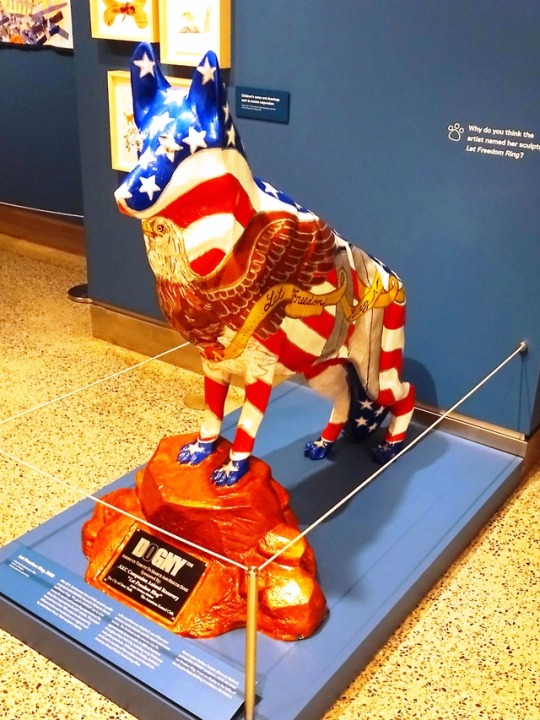
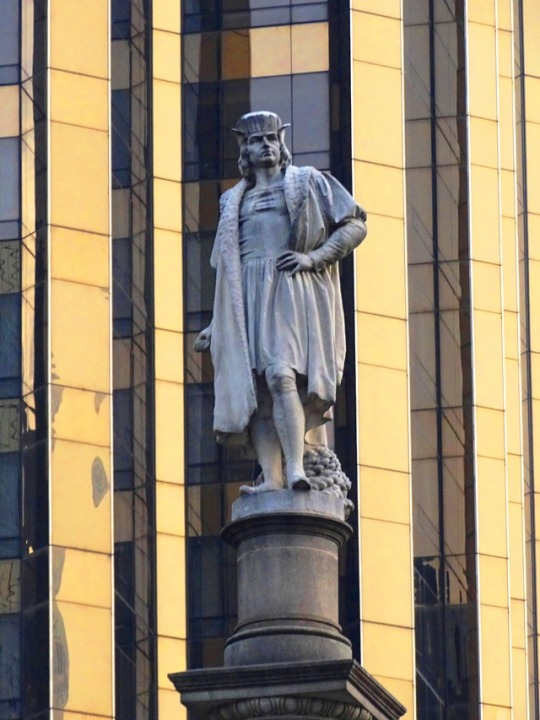

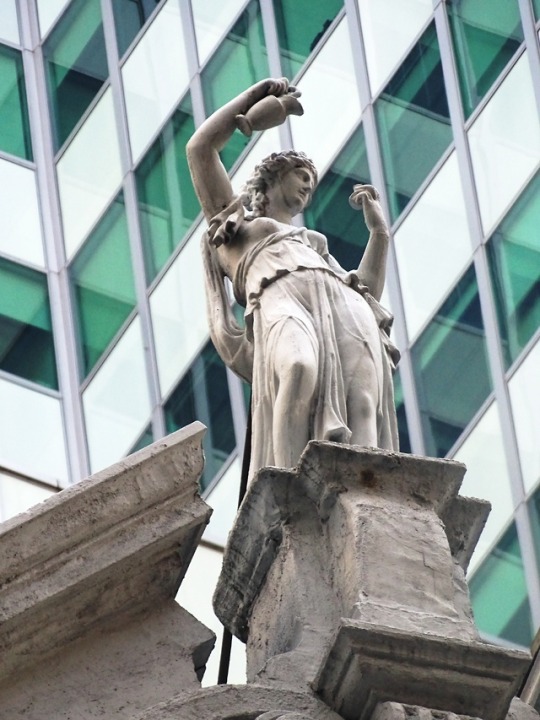
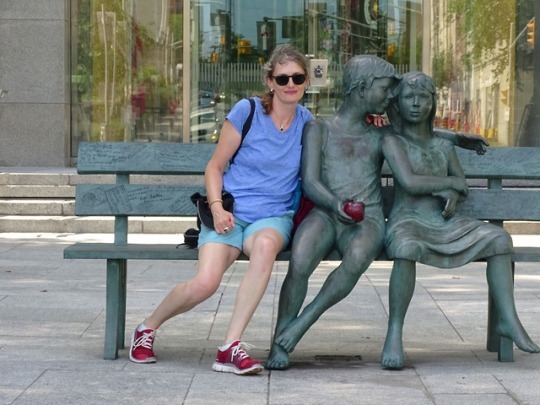
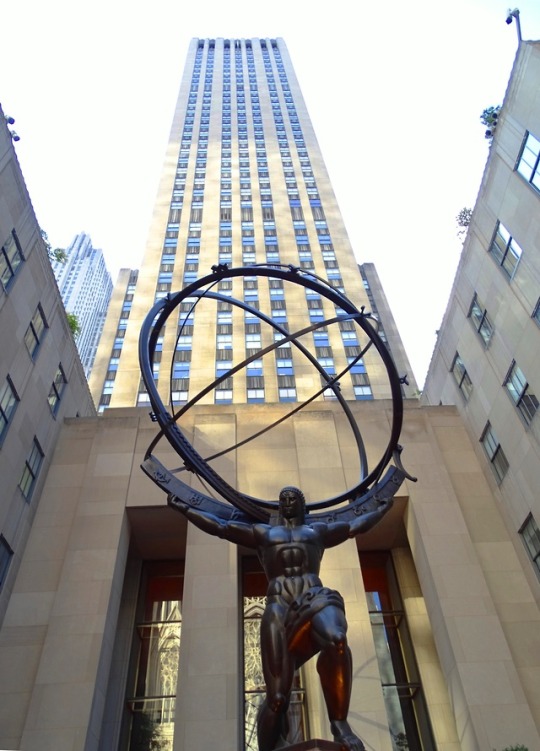
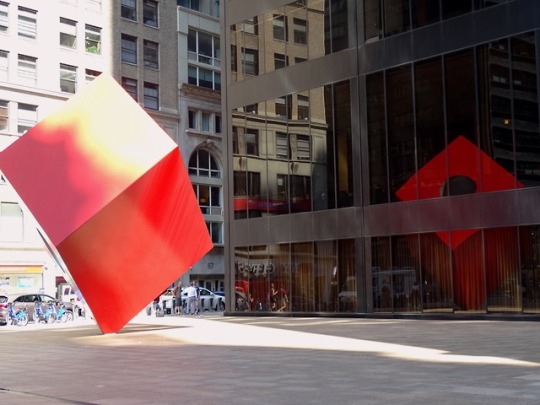
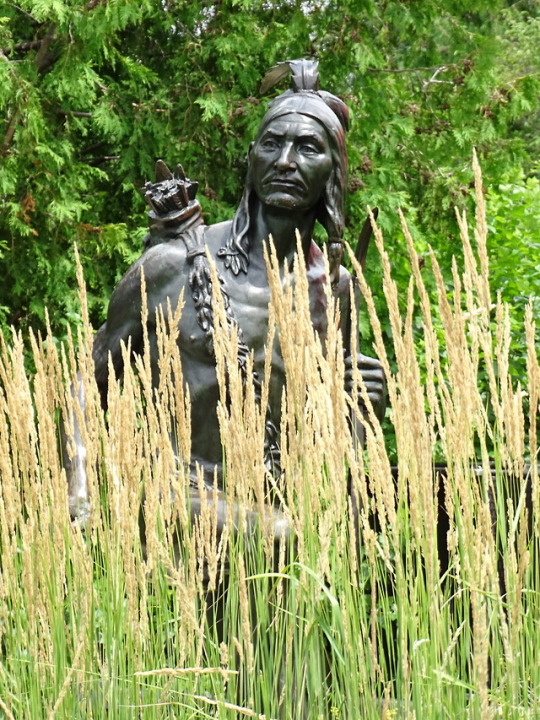
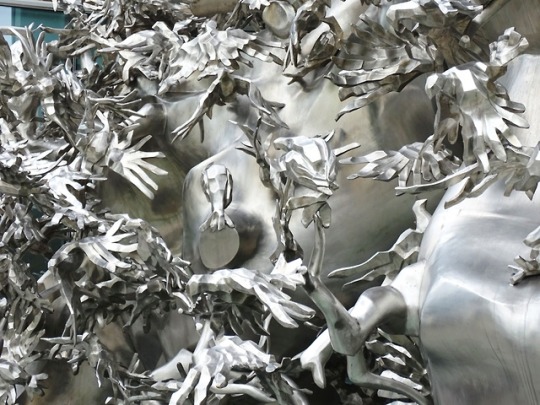
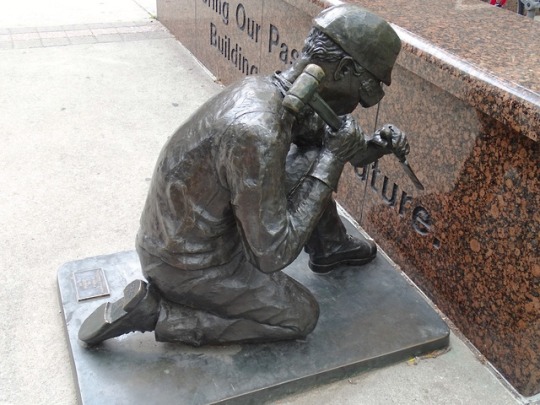
International Sculpture Day, April 24
International Sculpture Day is celebrated in over 20 countries. Sculptors and admirers come together to enjoy, encourage and show support through a variety of events designed to keep sculpture at the center of the celebration.
Source
International Sculpture Day, or IS Day, is a worldwide annual celebration of sculpture on April 24. It was established by the International Sculpture Center and is meant to raise awareness, appreciation and enjoyment of sculpture in communities across the globe. During the inaugural 2015 IS Day, over 50 events were held in 12 countries including Switzerland, China, Germany, England, Australia, Austria, Canada, Spain, New Zealand, and the USA. In its second year, over 200 events were held in 20+ countries including Australia, Denmark, Poland, Nigeria, Canada, France, Burkina Faso, Bolivia, Croatia and Mexico.
Types of IS Day events include open studios, demonstrations, workshops, public art tours, open museums, brown bag lunches, sculpture scavenger hunts, book signings, foundry pours, pop up exhibitions, opening receptions, competitions, artist talks, and more.
Source
#Let Freedom Ring by Kathryn Mellusi#International Sculpture Day#24 April#usa#public art#original photography#InternationalSculptureDay#summer 2018#New York City#Columbus by Gaetano Russo#Hebe#Toronto#The Glenn Gould Gathering by Ruth Abernethy#Canada#Ottawa#The Secret Bench of Knowledge by Lea Vivot#Atlas by Lee Lawrie and Rene Paul Chambellan#Anishinaabe Scout by Hamilton MacCarthy#The Cube by Isamu Noguchi#Rising by Zhang Huan#Anonymity of Prevention by Derek Lo and Lana Winkler#IS Day
1 note
·
View note
Photo










Art Deco/Art Nouveau Buildings (No. 88)
Rockefeller Center, New York City
#Rockefeller Center#art deco#art deco architecture#I love art deco so sue me#facade#exterior#Radio City Music Hall#neon sign#neon light#evening light#Edward Durell Stone#Donald Deskey#landmark#tourist attraction#5th Ave#building ornament#Atlas (1937) by Lee Lawrie and Rene Paul Chambellan#public art#sculpture#Midtown Manhattan#New York City#usa#summer 2018#detail#close up#bas-relief#grille#Morning Present Evening (1932) by Robert Garrison
107 notes
·
View notes
Photo
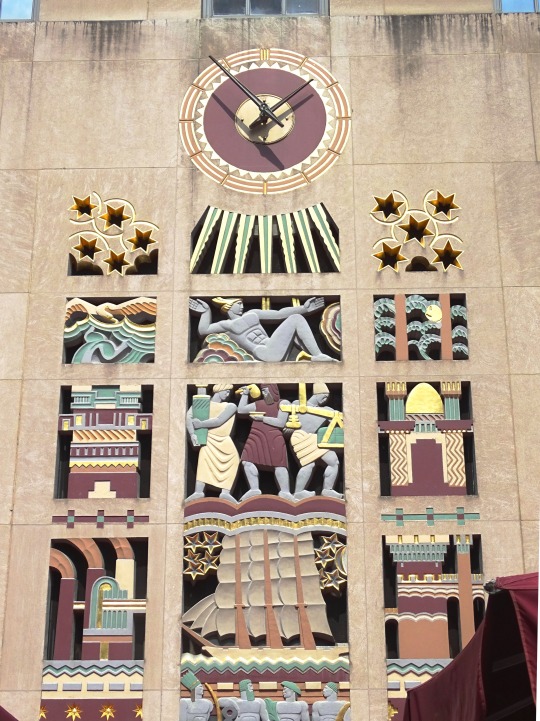
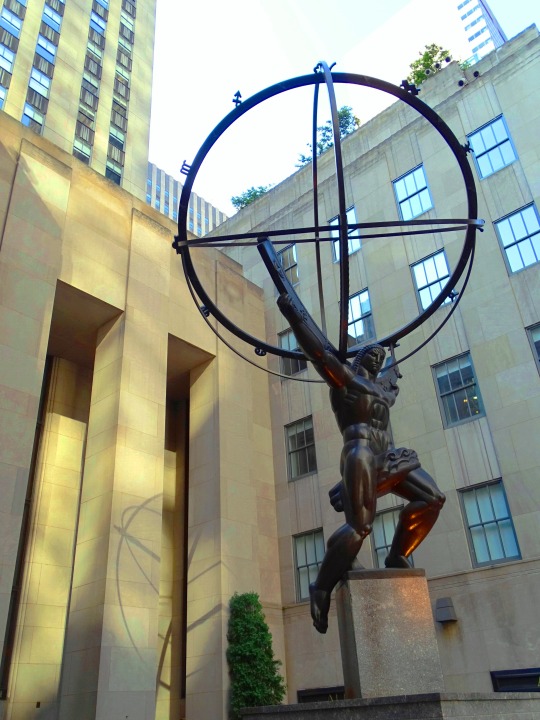

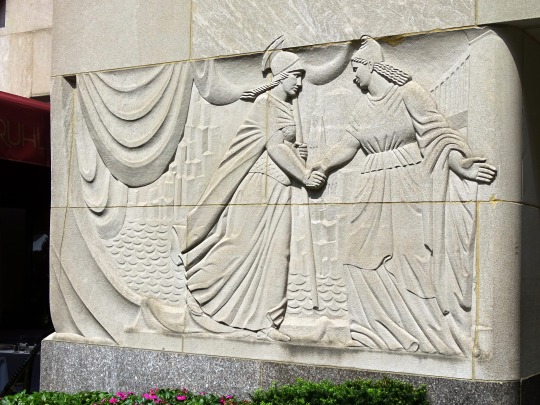





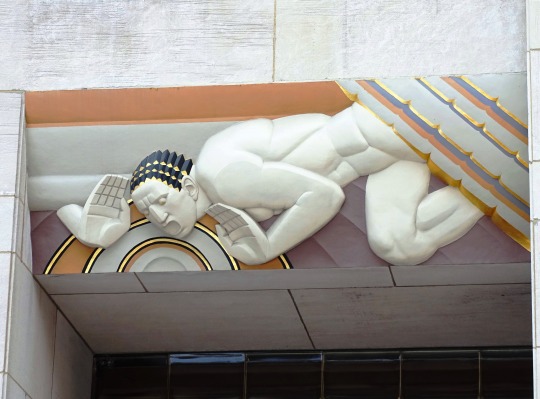
Art on the Rockefeller Center, Manhattan
In November 1931, John Todd suggested the creation of a program for placing distinctive artworks within each of the buildings. Hartley Burr Alexander, a noted mythology and symbology professor, was tasked with planning the complex's arts installations. Alexander submitted his plan for the site's artwork in December 1932. As part of the proposal, the complex would have a variety of sculptures, statues, murals, friezes, decorative fountains, and mosaics. In an expansion of Hood's setback-garden plan, Alexander's proposal also included rooftop gardens atop all the buildings, which would create a "Babylonian garden" when viewed from above.
At first, Alexander suggested "Homo Fabor, Man the Builder" as the complex's overarching theme, representing satisfaction with one's occupation rather than with the wage. However, that theme was not particularly well received by the architects, so Alexander proposed another theme, the "New Frontiers"; this theme dealt with social and scientific innovations and represented the challenges that humanity faced "after the conquest of the physical world". In theory, this was considered a fitting theme, but Alexander had been so specific about the details of the necessary artworks that it limited the creative license for any artists who would be commissioned for such works, so he was fired. It took several tries to agree on the current theme, "The March of Civilization", at which point some of the art had already been commissioned, including those which Alexander had proposed.
The art that currently exists within Rockefeller Center was inspired by Professor Alexander's arts program. Sculptor Lee Lawrie contributed the largest number of individual pieces – twelve, including the Atlas statue facing Fifth Avenue and the conspicuous friezes of Wisdom above the main entrance to 30 Rockefeller Plaza. Edward Trumbull coordinated the colors of the works located inside the buildings, and Léon-Victor Solon did the same job for the exterior pieces. Isamu Noguchi's gleaming stainless steel bas-relief, News, over the main entrance to 50 Rockefeller Plaza (the Associated Press Building) was, at the time of commissioning, the largest metal bas-relief in the world. The complex's other sculptors included Rene Chambellan, Leo Friedlander, Robert Garrison, Alfred Janniot, Carl Paul Jennewein, Gaston Lachaise, Leo Lentelli, Paul Manship, Giacomo Manzù, Hildreth Meiere, and Attilio Piccirilli. Other artists included Carl Milles, Margaret Bourke-White, and Dean Cornwell. Radio City Music Hall architect Donald Deskey commissioned many Depression-era artists to design works for the interior of the hall, including Stuart Davis's 1932 mural Men Without Women, named after the short story collection by Ernest Hemingway that had been published the same year. One of the center's more controversial works was Man at the Crossroads, created by Diego Rivera, which was originally commissioned for 30 Rockefeller Plaza's lobby but was demolished before it could be completed.
Source: Wikipedia
#ARMS OF ENGLAND by Lee Lawrie#Leon V. Solon#Rockefeller Center#USA#SAINT FRANCIS OF ASSISI WITH BIRDS#Art Deco#relief#exterior#travel#Raymond Hood#SWORDS INTO PLOWSHARES#architecture#cityscape#COLUMBIA GREETING A WOMAN AND BOATMAN UNFURLING A SAIL#clock#THE STORY OF MANKIND#façade#summer 2020#Midtown Manhattan#New York City#Light#Wisdom#Sound#Rene Paul Chambellan#Atlas#2018#Youth Leading Industry by Attilio Piccirilli
719 notes
·
View notes